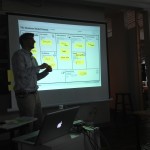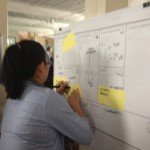Oct03
Innovating with Osterwalder’s Business Model Canvas #BIF8
Point: Create new business models using a visual, collaborative tool like Alex Osterwalder’s Business Model Canvas.
Story: Business models are complex, which makes them hard to talk about. A business has many interrelated moving pieces. It’s easy for you and your team to miss something when creating one. And with so much complexity and so many possibilities, it’s easy misunderstand each other when we try to invent new business models.
Luckily, there’s a solution. Alex Osterwalder’s Business Model Canvas is a visual tool that helps structure our thinking about business models.
At Osterwalder’s Business Model workshop at BIF8 last week, I saw the power of his Business Model Canvas firsthand. Osterwalder outlined the Canvas method and gave the group the assignment to generate a business model for a specific startup. Small groups clustered around their canvas and the room buzzed with discussion and the squeak of markers as participants took turns sketching out ideas. As we worked, I was struck by three key features of Osterwalder’s approach.
The first key feature was that Osterwalder encouraged sketching, not just making lists of words. “Any problem can be made clearer with a picture,” he said. The visual artifact lets people react to something concrete. To encourage people who think they can’t draw, Osterwalder pointed out that people can interpret a stick figure more easily than an abstract concept. “Drawing something, however badly, makes an abstract concept concrete, giving people an opportunity to react to it,” Osterwalder said. Visual thinking helps with understanding, dialogue, exploration and communication.
The second key feature was that Alex had us make our sketches and notes on Post-It® notes. We then stuck these to the Canvas. The key part was that then we could move the notes around as we figured out where on the canvas they belonged. “Post-It® notes are like containers of ideas,” Osterwalder said, that can be easily picked up and moved around. Thus, we could reconfigure our ideas as we refined them.
The third key feature was that the Canvas with its Post-It® notes ensures you don’t miss an important area. Because business models are so complex, with many interlocking pieces, it’s hard to hold all the pieces in memory and see their interactions and dependencies. The Canvas helps everyone see all the pieces and confirm that they work together and make sense. People can use different colors of Post-It notes for different business models, which lets them compare alternate models on the same Canvas. This side-by-side comparison can help to then pick the most promising model to test.
Action:
- If you’re working in a group, print the Canvas in large format (we used 3′ x 4′ at the workshop).
- Most people start on the righthand side of the Canvas, which is the customer side of your business model. It has the “Customer Segments,” “Channels,” and “Customer Relationships” areas. The lefthand side defines the infrastructure of the business with “Key Activities,” “Key Resources,” and “Partner Networks.” A central “Value Proposition” sits between the infrastructure areas that deliver on the proposition and the customer areas that receive the value. Finally, the “Cost Structure” and “Revenue Streams” areas on the bottom sit respectively under the infrastructure and customer sides of the canvas to define the financial side of the model.
- Play with different kinds of models. For example, Nestlé (in its Nespresso business) tested a model in which Nestlé sold its espresso machine through retail but sold the individual “pods” of coffee directly to consumers. Going direct was new to Nestlé but proved to be very lucrative because Nestle didn’t have to share revenue with the retailer.
- Keep interdependencies in mind. Every revenue stream, for example, must have a customer segment with an accompanying value proposition that makes it clear why they would pay. And every activity, resource, or partner might incur costs.
Sources:
Alex Osterwalder’s bestselling Business Model Generation book is a must!
Alex Osterwalder’s Business Model workshop at BIF8. See his calendar of upcoming speeches and workshops.
Alex Osterwalder’s slides on SlideShare, such as











